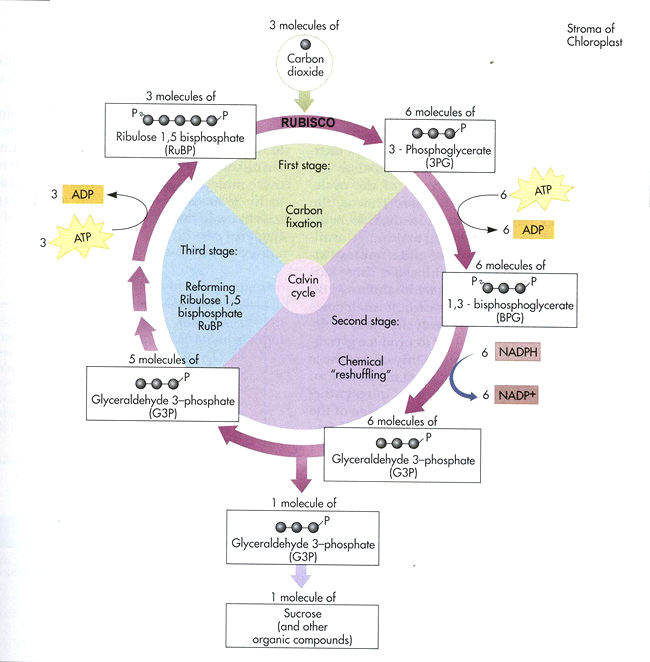The Calvin Cycle Reactions
(also called the Light Independent or Dark Reactions)
A. Overview
1. The Calvin Cycle is a series of reactions producing carbohydrates.
2. The cycle is named for Melvin Calvin who used a radioactive isotope of carbon
to trace the reactions.
3. The Calvin Cycle includes: carbon dioxide fixation, carbon dioxide reduction,
and regeneration of RuBP.
B. Fixation of Carbon Dioxide
1. CO2 fixation is the attachment of CO2 to an organic compound called RuBP.
2. RuBP (ribulose bisphosphate) is a five-carbon molecule that combines with
carbon dioxide.
3. The enzyme RuBP carboxylase (rubisco) speeds this reaction; this enzyme comprises
20–50% of theprotein content of chloroplasts, probably since it is a slow
enzyme.
C. Reduction of Carbon Dioxide
1. With reduction of carbon dioxide, a PGA (3-phosphoglycerate[C3]) molecule
forms.
2. Each of two PGA molecules undergoes reduction to PGAL in two steps.
3. Light-dependent reactions provide NADPH (electrons) and ATP (energy) to reduce
PGA to PGAL.
D. Regeneration of RuBP
1. Every three turns of Calvin cycle, five molecules of PGAL are used to re-form
three molecules ofRuBP.
2. Every three turns of Calvin cycle, there is net gain of one PGAL molecule;
five PGAL regenerate threemolecules of RuBP.
E. The Importance of the
Calvin Cycle
1. PGAL, the product of the Calvin Cycle can be converted into all sorts of
other molecules.
2. Glucose phosphate is one result of PGAL metabolism; it is a common energy
molecule.
3. Glucose phosphate is combined with fructose to form sucrose used by plants.
4. Glucose phosphate is the starting pint for synthesis of starch and cellulose.
5. The hydrocarbon skeleton of PGAL is used to form fatty acids and glycerol;
the addition of nitrogen forms various aminoacids.

